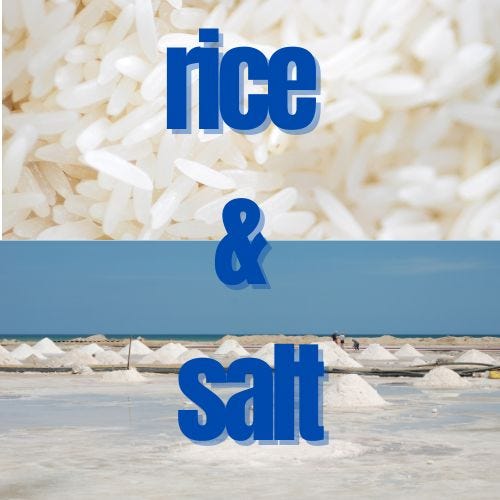se fly north against the moon.
Sons grow up and leave.
In the garden, my old bench.
Some days I’d rather have rice and salt.
Sit like a plant, neck outstretched:
Honk, honk! Fly away!
The title of this column, Rice and Salt, comes from a book I read last year: The Years of Rice and Salt by Kim Stanley Robinson. The book itself is a work of historical fiction, narrating an alternate route that history takes when the Black Death plague wipes out most of the European population. Throughout the book, we witness stories of different characters from ancient to modern times, living under a globe dominated by Chinese and Islamicate cultures instead of a European one.

The phrase “rice and salt” is used in the book by the character Widow Kang, who refers to “the days of rice and salt” as the mundane days a woman lives through while doing chores and taking care of children. I later found that the phrase is defined in the book Precious Records: Women in China’s Long Eighteenth Century by Susan Mann. She writes:
The tumultuous years of regular sexual relations, childbearing, and childbearing are glossed benignly in women's writings as the years of “rice and salt.” During this time, elite women often had to set aside literary interests and aesthetic pursuits in favor of the material needs of family members and the practical demands of household management.
Besides that, rice and salt as materials have traditionally been associated with spiritual and material cleansing. People would sprinkle them around the house, like how I have bowls of Himalayan salt set around my apartment.

But most simply, rice and salt are both used for food. I remember this Chinese story that was taught to me when I was young, where a man tasted salt on food for the first time and was amazed by how good it was. Later on, he acquires a bag of salt and foolishly dumps it all over his food, only to discover that it tastes terrible. It went something like that. The lesson is that good things are only good in moderation.
So I chose Rice and Salt as the title of this column not because of my fascination with that book, or because I’m living a childbearing life (I’m not), or that I have salt around my house, or because of that story I was taught. It’s more an accumulation of all of these things—the connection it has to Chinese tradition, the implication of something mundane, yet significant. In the most basic sense, this is all about food. It’s about Chinese food and culture, but it’s also about every other food and culture that has played a significant role in somebody’s life.
For this column, I want to find restaurants that serve hearty meals—like the ones somebody’s mom would make for them when they were young. I want to find desserts and bakeries that save a bad day. I want to find bars someone would frequent every week, just to take the edge off. Beyond that, I want to dig into arts and stories about food—whether from a movie or a book, a painting or a poem. I want to think about things that may help us learn, whether it’s about food, or me, or you, or the people around us.
But most importantly, I want to write to appreciate the act of eating, which is often unthought of or unthanked. Because in our days ahead—whether busy, mundane, or of rice and salt, whether good or bad, alone or together—there will always be a meal waiting.
Reference
Mann, Susan. Precious Records: Women in China’s Long Eighteenth Century. Stanford University Press, 1997.
Robinson, Kim Stanley. The Years of Rice and Salt. Bantam Books, 2002.
About Kai Hu
Kai Hu is a writer, curator, and artist currently in OCADu under the Visual and Critical Studies program. Primarily focused on academic writing, he also experiments with photography, film, illustration, and creative writing with pieces featured in various publications. His works include recurring themes such as leftist politics, East Asian culture, queer theories, nostalgia, and grief.
rice & salt will be published monthly.
Substack:





